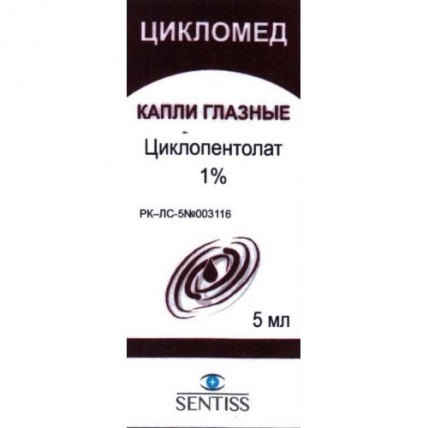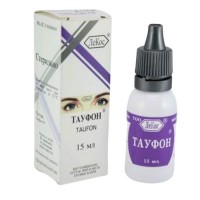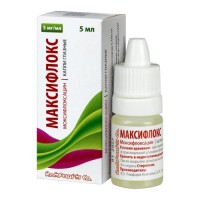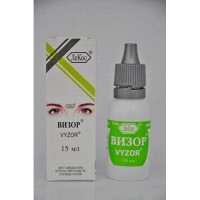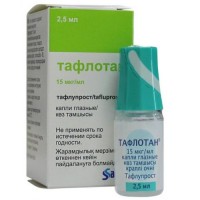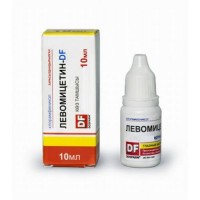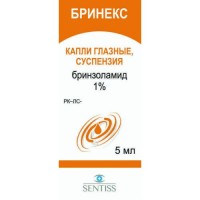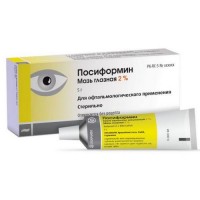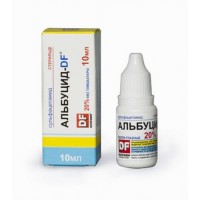The instruction for medical use
of medicine
the Cyclomedical
Trade name
the Cyclomedical
International unlicensed
name Tsiklopentolat Lekarstvennaya
the Drop form eye 1%
Structure
of 1 ml of drug contains
active agent - the tsiklopentolat a hydrochloride of 10 mg,
excipients: a benzalkoniya chloride, dinatrium edetat,
sodium chloride, sodium hydroxide, water for injections.
The description
Transparent, colourless solution
Pharmacotherapeutic group
Drugs for treatment of diseases of eyes. Midriatiki. Holinoblokatora.
Tsiklopentolat.
The ATX S01FA04 code
the Pharmacological
Pharmacokinetics Blocker properties of m-holinoretseptorov for topical administration in ophthalmology. Has mydriatic effect, complicates outflow of intraocular liquid, increases intraocular pressure, causes accommodation paralysis. At systemic action reduces secretion salivary, gastric, bronchial, sweat glands, a pancreas, reduces a tone of muscles of a GIT, bile ducts and a gall bladder, causes tachycardia, the conductivity improves AV. Excites a cerebral cortex in high doses.
Works quickly, but it is less long, than atropine. The maximum effect develops in 75 min. after instillation. Complete recovery of accommodation usually happens in 6-24 h, in individual cases - in several days.
Indications
- diagnostics of a research of an eyeground and definition of a refraction
- in an ophthalmosurgery in preoperative preparation at extraction of a cataract
- in complex therapy of inflammatory diseases of front department of an eye (episcleritis, a sclerite, a keratitis, an iridocyclitis, a uveitis)
Apply the Route of administration and doses to mydriasis locally, digging in 1 – 2 drop in a conjunctival sac.
Inspection of an eyeground – is dug in by 1-3 times on 1 drop in 10 minutes.
A refraction research at children and teenagers – 2-3 times on 1-2 drop in 15-20 minutes.
Inflammatory diseases of eyes - on 1 drop 3 times a day, in hard cases are allowed Tsiklomed's burying on 1 drop each 3 – 4 hours.
For decrease in system absorption it is recommended to press a lacrimonasal point during the procedure and within 2-3 min. after it (especially at children).
Side effects
- reddening of a conjunctiva, burning, sensation of discomfort after burying, blefarokonjyunktivit, a dot keratitis
- increase in intraocular pressure at patients with primary glaucoma, photophobia, decrease in visual acuity, irritation of eyes, hyperaemia
In rare instances of manifestation of systemic action (usually at children)
- weakness, nausea, dizziness, tachycardia, drowsiness, an intestines atony, a bladder atony, concern, hallucinations, superactivity, disturbance of temporary and spatial orientation
Other: skin rashes, an abdominal distension at children, thirst or dryness in a mouth, tachycardia, a hyper pyrexia, a vazodilatation, an ischuria, weakening of a vermicular movement of a GIT, reduction of secretion of glands (stalemate, salivary, mucous membranes of ENT organs and bronchial tubes)
of the Contraindication
- hypersensitivity to drug components
- suspicion of glaucoma, glaucoma
- posttraumatic paresis of musculus sphincter pupillae of an iris
- pregnancy and the period of a lactation
- children's age up to 8 years
Special instructions
At instillation of solution in a conjunctival sac in order to avoid hit of solution in a nasopharynx is reasonable to press the lower lacrimal opening. Cyclomedical is less effective at persons with dark pigmentary irises. At these persons when using drug the residual accommodation can reach 2 – 4 dioptries.
At children in the presence of a semi-resistant or resistant spasm of accommodation it is better to use a course of instillations of Atropini sulfas for a tsikloplegiya.
The persons sensitive to Atropini sulfas do not give a cross allergy to Tsiklomed that allows to apply it at this category of patients.
When developing photophobia for protection of eyes from UF-light it is necessary to wear sunglasses. If photophobia and/or blackout of sight does not pass within 36 hours after instillation, it is necessary to consult with the doctor.
At patients 40 years are more senior Tsiklomed's use demands control of intraocular pressure and carrying out a gonioskopiya if it is necessary.
To apply use in pediatrics With care at children after 8 years, at children with a Down syndrome, with spastic paralysis or cerebral disturbances, at light-blue-eyed children (it is characterized by hypersensitivity to action of the tsiklopentolat).
With care
Advanced age, intestinal impassability, a prostate hyperplasia.
The feature of influence of medicine on ability to run the vehicle or potentially dangerous mechanisms
to Patients is not recommended to run motor transport or to work with a difficult technique, machines or other difficult equipment.
Medicinal interactions
Tsiklomed's Effect can strengthen sympathomimetics (phenylephine hydrochloride), weaken – M-cholinomimetics (pilocarpine), cholinesterase inhibitors, Carbacholinum.
Overdose
At exact following to medical prescriptions of cases of overdose it was not observed. Symptoms: at increase in the recommended doses or at accidental administration of drug are inside possible: dryness of skin and mucous membranes, tachycardia, excitement, the incoherent speech, fatigue, disturbance of recognition of close located objects, a disorientation in time and space, change of an emotional state, at very high doses - paralysis of breath and a lump.
Treatment: intravenous administration of specific antidote – physostigmine, to children in a dose of 0.5 mg, if necessary (in the absence of effect in 5 min.) the dose is repeated (the maximum dose should not exceed 2 mg), the adult antidote enter 2 mg in a dose, in the absence of effect in 20 min. introduction repeat 1-2 mg in a dose.
Form of release and packing
of the Drop eye 1%.
On 5 ml of drug in plastic bottles droppers.
On 1 bottle dropper together with the screw-on cap in which there is a device for opening of a bottle and with the instruction for medical use in the state and Russian languages place in a cardboard pack.
To Store storage conditions in the place protected from light at a temperature not above 25 °C.
Not to freeze.
To store out of children's reach!
A period of storage
2 years
the use Period after opening of a bottle 1 month.
Not to use after the expiry date specified on packing!
Prescription status
According to the prescription
of Proizvoditel SENTISS FARM Pvt. Ltd.
212/D-1, Greene Park, New Delhi, India
At the plant: Villidzh Khera Nikhla, Tekhsil Nalagarkh, Region of Solan, Himachal Pradesh 174,101, India
Name and country of the owner of the registration certificate
of SENTISS FARMA of Pvt. Ltd., India
the Address of the organization accepting in the territory of the Republic of Kazakhstan claims from consumers on quality of products:
Republic of Kazakhstan, 050000, Almaty, Bogenbay St. of the Batyr 132, office 309
Ph./fax: +7 (7272) 96-45-99
Email: sentiss_kz@land.ru
of medicine
the Cyclomedical
Trade name
the Cyclomedical
International unlicensed
name Tsiklopentolat Lekarstvennaya
the Drop form eye 1%
Structure
of 1 ml of drug contains
active agent - the tsiklopentolat a hydrochloride of 10 mg,
excipients: a benzalkoniya chloride, dinatrium edetat,
sodium chloride, sodium hydroxide, water for injections.
The description
Transparent, colourless solution
Pharmacotherapeutic group
Drugs for treatment of diseases of eyes. Midriatiki. Holinoblokatora.
Tsiklopentolat.
The ATX S01FA04 code
the Pharmacological
Pharmacokinetics Blocker properties of m-holinoretseptorov for topical administration in ophthalmology. Has mydriatic effect, complicates outflow of intraocular liquid, increases intraocular pressure, causes accommodation paralysis. At systemic action reduces secretion salivary, gastric, bronchial, sweat glands, a pancreas, reduces a tone of muscles of a GIT, bile ducts and a gall bladder, causes tachycardia, the conductivity improves AV. Excites a cerebral cortex in high doses.
Works quickly, but it is less long, than atropine. The maximum effect develops in 75 min. after instillation. Complete recovery of accommodation usually happens in 6-24 h, in individual cases - in several days.
Indications
- diagnostics of a research of an eyeground and definition of a refraction
- in an ophthalmosurgery in preoperative preparation at extraction of a cataract
- in complex therapy of inflammatory diseases of front department of an eye (episcleritis, a sclerite, a keratitis, an iridocyclitis, a uveitis)
Apply the Route of administration and doses to mydriasis locally, digging in 1 – 2 drop in a conjunctival sac.
Inspection of an eyeground – is dug in by 1-3 times on 1 drop in 10 minutes.
A refraction research at children and teenagers – 2-3 times on 1-2 drop in 15-20 minutes.
Inflammatory diseases of eyes - on 1 drop 3 times a day, in hard cases are allowed Tsiklomed's burying on 1 drop each 3 – 4 hours.
For decrease in system absorption it is recommended to press a lacrimonasal point during the procedure and within 2-3 min. after it (especially at children).
Side effects
- reddening of a conjunctiva, burning, sensation of discomfort after burying, blefarokonjyunktivit, a dot keratitis
- increase in intraocular pressure at patients with primary glaucoma, photophobia, decrease in visual acuity, irritation of eyes, hyperaemia
In rare instances of manifestation of systemic action (usually at children)
- weakness, nausea, dizziness, tachycardia, drowsiness, an intestines atony, a bladder atony, concern, hallucinations, superactivity, disturbance of temporary and spatial orientation
Other: skin rashes, an abdominal distension at children, thirst or dryness in a mouth, tachycardia, a hyper pyrexia, a vazodilatation, an ischuria, weakening of a vermicular movement of a GIT, reduction of secretion of glands (stalemate, salivary, mucous membranes of ENT organs and bronchial tubes)
of the Contraindication
- hypersensitivity to drug components
- suspicion of glaucoma, glaucoma
- posttraumatic paresis of musculus sphincter pupillae of an iris
- pregnancy and the period of a lactation
- children's age up to 8 years
Special instructions
At instillation of solution in a conjunctival sac in order to avoid hit of solution in a nasopharynx is reasonable to press the lower lacrimal opening. Cyclomedical is less effective at persons with dark pigmentary irises. At these persons when using drug the residual accommodation can reach 2 – 4 dioptries.
At children in the presence of a semi-resistant or resistant spasm of accommodation it is better to use a course of instillations of Atropini sulfas for a tsikloplegiya.
The persons sensitive to Atropini sulfas do not give a cross allergy to Tsiklomed that allows to apply it at this category of patients.
When developing photophobia for protection of eyes from UF-light it is necessary to wear sunglasses. If photophobia and/or blackout of sight does not pass within 36 hours after instillation, it is necessary to consult with the doctor.
At patients 40 years are more senior Tsiklomed's use demands control of intraocular pressure and carrying out a gonioskopiya if it is necessary.
To apply use in pediatrics With care at children after 8 years, at children with a Down syndrome, with spastic paralysis or cerebral disturbances, at light-blue-eyed children (it is characterized by hypersensitivity to action of the tsiklopentolat).
With care
Advanced age, intestinal impassability, a prostate hyperplasia.
The feature of influence of medicine on ability to run the vehicle or potentially dangerous mechanisms
to Patients is not recommended to run motor transport or to work with a difficult technique, machines or other difficult equipment.
Medicinal interactions
Tsiklomed's Effect can strengthen sympathomimetics (phenylephine hydrochloride), weaken – M-cholinomimetics (pilocarpine), cholinesterase inhibitors, Carbacholinum.
Overdose
At exact following to medical prescriptions of cases of overdose it was not observed. Symptoms: at increase in the recommended doses or at accidental administration of drug are inside possible: dryness of skin and mucous membranes, tachycardia, excitement, the incoherent speech, fatigue, disturbance of recognition of close located objects, a disorientation in time and space, change of an emotional state, at very high doses - paralysis of breath and a lump.
Treatment: intravenous administration of specific antidote – physostigmine, to children in a dose of 0.5 mg, if necessary (in the absence of effect in 5 min.) the dose is repeated (the maximum dose should not exceed 2 mg), the adult antidote enter 2 mg in a dose, in the absence of effect in 20 min. introduction repeat 1-2 mg in a dose.
Form of release and packing
of the Drop eye 1%.
On 5 ml of drug in plastic bottles droppers.
On 1 bottle dropper together with the screw-on cap in which there is a device for opening of a bottle and with the instruction for medical use in the state and Russian languages place in a cardboard pack.
To Store storage conditions in the place protected from light at a temperature not above 25 °C.
Not to freeze.
To store out of children's reach!
A period of storage
2 years
the use Period after opening of a bottle 1 month.
Not to use after the expiry date specified on packing!
Prescription status
According to the prescription
of Proizvoditel SENTISS FARM Pvt. Ltd.
212/D-1, Greene Park, New Delhi, India
At the plant: Villidzh Khera Nikhla, Tekhsil Nalagarkh, Region of Solan, Himachal Pradesh 174,101, India
Name and country of the owner of the registration certificate
of SENTISS FARMA of Pvt. Ltd., India
the Address of the organization accepting in the territory of the Republic of Kazakhstan claims from consumers on quality of products:
Republic of Kazakhstan, 050000, Almaty, Bogenbay St. of the Batyr 132, office 309
Ph./fax: +7 (7272) 96-45-99
Email: sentiss_kz@land.ru
